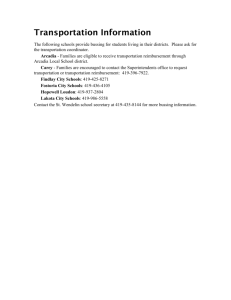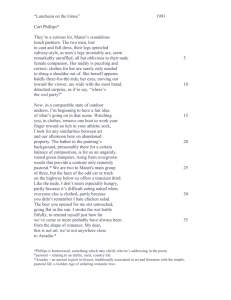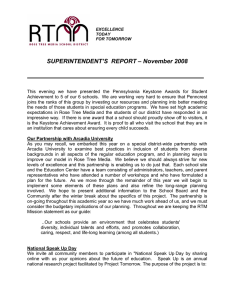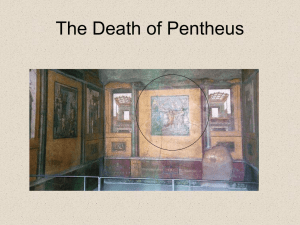Darwin in Arcadia: Evolutionary Biology’s Challenge to the Pastoral Imagination
advertisement
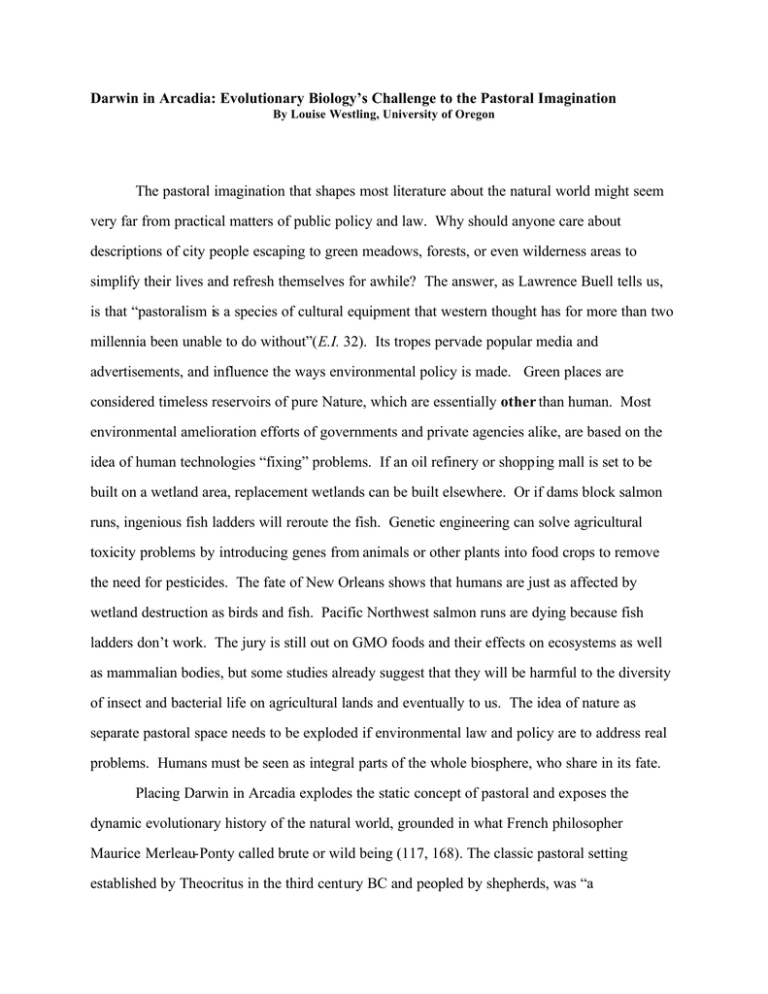
Darwin in Arcadia: Evolutionary Biology’s Challenge to the Pastoral Imagination By Louise Westling, University of Oregon The pastoral imagination that shapes most literature about the natural world might seem very far from practical matters of public policy and law. Why should anyone care about descriptions of city people escaping to green meadows, forests, or even wilderness areas to simplify their lives and refresh themselves for awhile? The answer, as Lawrence Buell tells us, is that “pastoralism is a species of cultural equipment that western thought has for more than two millennia been unable to do without”(E.I. 32). Its tropes pervade popular media and advertisements, and influence the ways environmental policy is made. Green places are considered timeless reservoirs of pure Nature, which are essentially other than human. Most environmental amelioration efforts of governments and private agencies alike, are based on the idea of human technologies “fixing” problems. If an oil refinery or shopping mall is set to be built on a wetland area, replacement wetlands can be built elsewhere. Or if dams block salmon runs, ingenious fish ladders will reroute the fish. Genetic engineering can solve agricultural toxicity problems by introducing genes from animals or other plants into food crops to remove the need for pesticides. The fate of New Orleans shows that humans are just as affected by wetland destruction as birds and fish. Pacific Northwest salmon runs are dying because fish ladders don’t work. The jury is still out on GMO foods and their effects on ecosystems as well as mammalian bodies, but some studies already suggest that they will be harmful to the diversity of insect and bacterial life on agricultural lands and eventually to us. The idea of nature as separate pastoral space needs to be exploded if environmental law and policy are to address real problems. Humans must be seen as integral parts of the whole biosphere, who share in its fate. Placing Darwin in Arcadia explodes the static concept of pastoral and exposes the dynamic evolutionary history of the natural world, grounded in what French philosopher Maurice Merleau-Ponty called brute or wild being (117, 168). The classic pastoral setting established by Theocritus in the third century BC and peopled by shepherds, was “a 2 Westling---Darwin in Arcadia, UVA Law, October ‘05 conventional, closed landscape . . . where water peacefully flows, [and] the foliage of the trees rustles, . . .” Idyllic modulation between the contemporary and the mythic in such places allows imaginative escape from cities to natural tranquility and simplicity (Oxford Classical Dictionary 787). Since the Renaissance this conventional space of nature has been expanded to include forests and gardens, as we see in familiar works like Shakespeare’s Midsummer Night’s Dream and As You Like it. After Kant and the Romantic Sublime, the pastoral impulse opened out to include much wilder scenes as European and American writers began to extol craggy mountains, tempestuous seascapes, and eventually the idea of wilderness (N icolson 1-33, 271-323; Cronon 72-76). But always nature has been assumed to be a separate sphere which humans visit for temporary respite. “At the root of pastoral,” explains Greg Garrard, “is the idea of nature as a stable, enduring counterpoint to the disruptive energy and change of human societies” (56). Seen in evolutionary terms, however, pastoral space cannot be understood as separate from ordinary human settings. Instead it must include all of the earth, with homo sapiens only one among myriads of interrelated and interdependent species of living creatures. According to biologist E. O. Wilson, For more than 99 percent of human history people have lived in hunter-gatherer bands totally and intimately involved with other organisms. During this period of deep history, and still farther back, into paleohominid times, they depended on an exact learned knowledge of crucial aspects of natural history. That much is true even of chimpanzees today, who use primitive tools and have a practical knowledge of plants and animals. As language and culture expanded, humans also used living organisms of diverse kinds as a principal source of metaphor and myth. In short, the brain evolved in a biocentric world, not a machine-regulated world. It would be therefore quite extraordinary to find that all learning rules related to that world have been erased in a few thousand years, even in the tiny minority of peoples who have existed for more than one or two generations in wholly urban environments (“Biophilia and the Conservation Ethic,” in The Biophilia Hypothesis ed. Stephen R. Kellert and Edward O. Wilson. Washington, D.C.: Island Press, 1993. p. 32). The most ancient literatures express a sense of this immersion in the natural world in kinship with other organisms, as Buell remarks (Future 1-2). In almost every culture the earliest 3 Westling---Darwin in Arcadia, UVA Law, October ‘05 writings are concerned with the creation of plants and animals, and the oral traditions which preceded ancient literature and still linger in some parts of the globe posit kinship, shapeshifting, and dialogue between humans and the other creatures around them. It is likely that the highly conventional and artificial genre of pastoral poetry owes its origins to folk traditions of this sort (Oxford Classical Dictionary 786). Indeed, my colleague Glen Love suggests that the pastoral has far more ancient roots, when he asserts that evolutionary perspectives help to explain why most human cultures are deeply attracted to green places of repose and natural abundance. He advocates the application of E.O. Wilson’s concepts of biophilia and consilience —indeed sociobiology—to literary environmentalism (70, 76). While I am not so confident about the efficacy of sociobiology, I would like to consider Darwinian perspectives on the pastoral in what I hope is a complementary way to Love’s work, by focusing particular attention upon what Merleau-Ponty called “man-animality intertwining” within the flesh of the natural world (274). Taking seriously what Darwin’s legacy means for our assumptions about the natural world means rethinking Arcadia as a co-evolving tangle of beings and forms that covers the planet. Then we begin to see that the human species is intrinsically wild, as Gary Snyder has suggested, or grounded in brute existence, in Maurice Merleau-Ponty’s terms. “Our bodies are wild,” says Snyder. “The involuntary quick turn of the head at a shout, the vertigo at looking off a precipice, the heart- in-the-throat in a moment of danger, the catch of the breath, the quiet moments relaxing, staring, reflecting—all universal responses of this mammal body” (16). Merleau-Ponty puts it more abstractly: “This environment of brute existence and essence is not something mysterious: we never quit it, we have no other environment” (117). John Dewey suggested that modern civilization has frozen the basic disorder underlying the institutional life of humanity into static formal divisions. 4 Westling---Darwin in Arcadia, UVA Law, October ‘05 The institutional life of mankind is marked by disorganization. This disorder is often disguised by the fact that it t akes the form of static division into classes, and this static separation is accepted as the very essence of order as long as it is so fixed and so accepted as not to generate open conflict ( 20). When such forms are disrupted or broken apart during natural disasters such as the recent tsunami in Indonesia, the dissolution of political structures in Baghdad after the fall of Saddam Hussein, or the collapse of public institutions in New Orleans after hurricane Katrina, we see anarchy and open conflict erupt. For Dewey, such wild behaviors are part of our kinship with all other living beings, and our long history together. While man is other than bird and beast, he shares basic vital functions with them and has to make the same basal adjustments if he is to continue the process of living. Having the same vital needs, man derives the means by which he breathes, moves, looks, and listens, the very brain with which he coordinates his senses and his movements, from his animal forbears. The organs with which he maintains himself in being are not of himself alone, but by the grace of struggles and achievements of a long line of animal ancestry (13). To understand the wild or brute existence of which homo sapiens remains an integral part, we have to acknowledge our animal selves, reexamining relationships with other animals, and by implication the places where we all live. Thus we return to the perspectives Charles Darwin expressed in The Origin of Species and The Descent of Man. He insisted that “there is no fundamental difference between man and the higher mammals in their mental faculties” (Descent 214). He found similar emotions and behaviors among ants as among humans (223). He painstakingly itemized the structural homologies between humans and other mammals, as well as pointing out parallels in fetal development (178-182). And he credited other animals with cultural behaviors, reasoning abilities, and abilities to communicate in complex ways. A return to this kind of thinking has been gathering momentum recently in ethology, primatology, and other animal studies, cultural studies, and critical theory (See, for example, Jolly, De Waal, Smuts, Yoerg, Masson and McCarthy). Westling---Darwin in Arcadia, UVA Law, October ‘05 I hope it is obvious, however, that these debts to Darwin’s thought are far from what Steven Rose calls “ultra-Darwinism,” a sort of Hobbesian vision of ruthless struggle for reproductive success and adaptation at the level of the “selfish gene” that renders organisms mere robots (Rose 209-214). Such thinking oversimplifies Darwin’s picture of evolution, and much evolutionary biology of the past century has added further nuances and complications to the picture of how living creatures developed in new forms over the millions of years of planetary life (Rose 215-249). One of the most powerful challenges to the caricature of survival of the fittest through relentless competition is Lynn Margulis’s theory of symbiogenesis, which once seemed heretical but “has now become the conventional wisdom of the textbooks,” according to Rose (229). Margulis’s theory suggests that “symbiosis, beginning as an uneasy alliance of distinct life- forms, may underlie the origin of major evolutionary novelty” (20). Explanations of punctuated equilibrium, the fact that many evolutionary events seemed to happen in sudden leaps rather than gradual adaptive development, also indicate other forces at work than mere competition for survival (Rose 224, Jolly 128-129). In cultural studies, increasing attention is focusing on the question of human/animal relations hips, viewed from the perspectives of many disciplines. Indeed the most influential arbiter of postructural theory, Jacques Derrida, had been working on this subject for more than a decade when he died in 2004, leaving an 800-page manuscript yet to be pub lished. Cary Wolfe’s Zoontologies (2003) and Animal Rites (2003) bring together a representative sample of recent interdisciplinary work on the question of the animal, and Greg Garrard has devoted a chapter to “Animals” in his recent book Ecocriticism, introducing the new field of environmental literary study. Ironically, as species extinction intensifies around the globe, we turn to recognize the ways in which humans have always been dancing in a communal embrace with millions of others, many of them in our bodies. Westling---Darwin in Arcadia, UVA Law, October ‘05 Individual bodies turn out themselves to be far from discrete entities but rather cavorting alliances of creatures in intricately choreographed patterns. As human animals we live in symbiosis with thousands of species of anaerobic bacteria. Six hundred species in our mouths neutralize the toxins all plants produce to ward off their enemies. Four hundred species colonize our intestines; without them we could not digest and absorb the food we eat (Lingus 2003: 166). Tiny creatures live all over our bodies, eating dead skin and performing many other kinds of housekeeping functions, as for example the microscopic lobster- like insects that infest our eyelashes and continually clean away the lubricants that would otherwise glue our eyes shut. As we move and breathe, we actively exchange nutrients and waste, energy and even atoms, with the air and things around us and the millions of creatures within us. Each person is a bipedal, mobile, and self-conscious community of living agents sharing an inner sea bound by the semipermeable extended surface organ of skin and given firm shape by bones. Armies of friendly microbes swim through our inner seas, scouting for and devouring invaders, cleaning the pipes, carrying freight. The “human” DNA that shapes and marks each of our unique selves is far less a proportion of the DNA in our body mass than that of our microbe friends. Even within our individual cells, the mitochondria that make our energy have their own, different DNA than that in our “human” chromosomes (Margulis 22). Conscious thought—the much-vaunted mind that has dominated philosophical tradition for two and a half thousand years—is only a tiny winking of self-reflective light in this symbiotic community of our body. Only a small part of that self-consciousness is focused in the deliberate kind of attention we call ‘reason’ or “logic.” The individual human agent is not the queen of her fate or the master navigator of his life’s course. As philosopher Alfonso Lingis puts it, our bodies are like ‘coral reefs . . . continually stirred by monsoon climates of moist air, blood, and biles. Movements do not get launched by an agent against masses of intertia; we move in an environment of air currents, rustling trees, and animate bodies’ (167). As Margulis explains in Symbiotic Planet, Westling---Darwin in Arcadia, UVA Law, October ‘05 We are a kind of baroque edifice, . . . rebuilt every two decades or so by fused and mutating symbiotic bacteria. Our bodies are built from protoctist sex cells that clone themselves by mitosis. Symbiotic interaction is the stuff of life on a crowded planet. Our symbiogenetic composite core is far older than the recent innovation we call the individual human. Our strong sense of difference from any other life-form, our sense of species superiority, is a delusion of grandeur (98). All around us are other living beings and forces whose worlds intersect or overlap with ours, as Jakob Von Uexküll explained in A Stroll Through the Worlds of Animals and Men. These environments or umwelten differ from each other at the same time that they interweave, because each creature subjectively creates its own environment, or umwelt, through the perceptions which its sense organs allow it to experience. Von Uexküll’s original contribution of the subjective umwelt concept richly complicated the philosophical implications of evolutionary biology, because the notion of multiple coexisting umwelten constitutes a kind of biological analogue to General Relativity and literally reveals the simultaneous existence of multiple realities. The subjective significances of the world that can be experienced in each of these realities determines the very shape of each creature within it. Von Uexküll likened the motivating, shaping force of each distinctive cell to a chime, and that of an organ or organism to a melody which cannot be explained mechanically but which follow their own laws of growth (34, 37) in a participatory relationship with the world around them. The example of the octopus reveals this interrelationship: The rule that governs the properties of sea-water acts upon the composition of the living chime of the cells of protoplasm of the octopus embryo. It shapes the melody of the development of the octopus form to express the properties of sea-water in a counterpoint; first and foremost, an organ is produced whose muscular walls force the water in and out. The rule of meaning that joins point and counterpoint is expressed in the action of swimming (53). As I mentioned previously, traditional peoples used to understand the intertwining of creatures with their environments or umwelten and with each other, though they would have described that understanding in rather different terms than ours. Oral traditions from all over Westling---Darwin in Arcadia, UVA Law, October ‘05 the world tell stories of humans conversing with other animals as relatives, being aided by them or tricked by them, and always remaining closely associated in a shared world even though each may experience it in quite different ways. Acoma Pueblo Indian people of the American Southwest believe that their ancestors emerged from underground, aided by a wise spider and a locust (Erdoes and Ortiz 97-105). People of my Pacific Northwest region tell stories of a woman who married a bear and turned into one (Erdoes and Ortiz 419-423), of another woman who made fun of frogs and was forced to marry one (Turner, 217-218), of trickster heroes Coyote or Raven who intervene in human and other creatures’ affairs (Erdoes and Ortiz 171-172, 318-319, 344-346). Ancient Celts in Ireland believed that humans could turn into swans (Jackson 93-97). The development of agriculture and urban civilizations eroded that sense through a long, gradual process, but the earliest literatures are haunted by fears of what happens when humans try to set themselves outside or above these wider kinships. Some of the earliest literary works document the uneasy sense of human animal intertwining during the Bronze Age when agriculture and cities were well- established, and we might look briefly at one of these, Euripides’ Bakkhai, written about 40 BC. The Bakkhai of Euripides This play contrasts the human-controlled city of Thebes with pastoral meadows and hills outside it, where natural forces seem to reign, in order to dramatize anxieties about human/animal relationships and the tragic consequences of pretend ing that they do not exist. 1 The story of King Pentheus’s demise involves an arrogant young king who tries to impose human will upon wildness, an epicene doppleganger who is closely associated with wild animals, shifting boundaries between human and non-human forms, and death as the 1 E. R. Dodds explains in his introduction to his edition of Euripides Bacchae that the formal qualities of this play are unusually archaic, marking it as the most ancient material the poet ever reshaped (xxxvi- xxxvii). The traditional nature of many scenes is attested on vase paintings that long predate Euripides (xxxiii- xxvi). Westling---Darwin in Arcadia, UVA Law, October ‘05 consequence for defying the sacred powers of the natural world. A close examination of the tragedy reveals that both Pentheus and his cousin, the god Dionysos, are intimately animal, both having strange genealogies including snaky, bovine, and leonine forbears, both metamorphosing into some of these different species at given points in the play. Boundaries and distinctions among species are not secure at all in this strange world. The tragedy that reenacts the sacrifice by which Dionysos is torn to pieces in some versions of his myths, comes about because Pentheus refuses to acknowledge his own animality and the wild forces both embodied in and manipulated by his divine double. Translator Robert Bagg describes “Euripides’s bitter vision of an implacable divine presence not outside, but within our nature, a presence utterly hostile to what we uneasily call our humanity” (14). One could qualify Bagg’s point, however, by suggesting that the only reason this divine presence becomes so implacable and violent in the events we witness is that Pentheus enrages the god by refusing to worship him. Pentheus and Dionysos (or Bakkhus) are about the same age and look similar, except that Dionysos has flowing hair and almost feminine features, while Pentheus is a hypermasculine military man determined to condemn the god’s worship in his city of Thebes. The Chorus of Maenad worshipers informs the audience that Dionysos was born bull- headed and writhing with snakes in Crete. He is also associated with twining ivy, leopards and lions, and of course the grape (Dodds 76-79). But Pentheus himself is the son of a man whose name Echion means “snake” and who sprang up from the earth when Kadmos, the slayer of a mighty serpent sowed the monster’s teeth in the earth (Bagg 8, 28). Kadmos is Pentheus’s grandfather, whose daughter Agave married this serpent’s offspring, and Dionysos announces at the end of the play that he will turn Kadmos and his daughter into serpents to punish them for their impiety (Bagg 66-67, Oxford Classical Dictionary, 187). This genealogy remains just under the surface of the play’s action but is hinted frequently by puns and choral epithets for the god, as both E.L. Dodds and Robert Bagg make Westling---Darwin in Arcadia, UVA Law, October ‘05 clear in their introductions to the text, and the Greek audience would have been fully attuned to these uncanny associations. But Pentheus is so determined to maintain his rational, human control of himself and his kingdom that he has buried them far from his consciousness. When he confronts the young stranger who is Dionysos in disguise, he is alternately attracted and infuriated by him. He tries to chain him up and throw him in prison, but the stranger turns into a wild bull and cannot be held by his jailers. Pentheus’s sacrilege is punished by earthquake and fire, but the young king refuses to understand (Bagg 40-41). Finally, Dionysos so befuddles him that he agrees to dress in women’s clothes and go to spy on the Bakkhic worship performed by his mother and the other women, outside the city in the pastoral space of wild meadows and hills. By this point Pentheus’ vision is blurred, so that when he looks at the magical stranger, he sees him trotting like a bull, with horns sprouting from his head. Pentheus wonders whether he is seeing distortions and asks Dionysos, “were you always . . . animal?/ There’s no question you’re a bull now” (50). The fatal climax happens offstage, when the worshipers see Pentheus spying from his hiding place in a tree, tear it down and rip him to pieces in the ritual practices of sparagmos and omophagia central to ancient Dionysian worship–the tearing to pieces of a live animal and the eating of its raw flesh (Dodds xvi- xix, Bagg 56-57, Oxford Classical Dictionary). Although this instance of the god’s worship is particularly gruesome, it implies a general truth—there is no resisting the metamorphosis of animal forms, of which humans are only a temporary manifestation. Eating and drinking, the nourishing of human bodies, requires violent tearing of other bodies, and ingesting their flesh. Because Pentheus and his mother refused to acknowledge their subordinate part in this sacrificial economy and their dependence upon the powers of the natural world which Dionysos represents, they become sacrificial victims themselves. The moral structures of Euripides’s play are complex and confusing, but at its heart is the insistence on human kinship with all other life in both harmonious and violent relationships which cannot be long denied or resisted. Westling---Darwin in Arcadia, UVA Law, October ‘05 The Bakkhai is a very ancient literary work, liminal in its attempt to rationalize traditional beliefs about human relationships with other animals and the wild energies MerleauPonty associated with the Brute being that permeates all life, while also retaining deep fears about the costs of civilization with its presumptions of separation from nature and all other animals. Examples of other such ancient works can be multiplied from many cultures. In the millennia that have intervened since they were written, anxieties about human membership in the larger biotic community seem gradually to have ebbed, as the apparent control of the nonhuman world and other animals by our species increased. Since the Industrial Revolution of the eighteenth and nineteenth centuries, developing technologies have seemed to prove the superiority of homo sapiens over all others. As Arthur Lovejoy established long ago, the patterns of dualistic thought in European culture which separate humans from nature and other animals, mind from body, and spirit from matter can actually be traced back in strong, explicit written form at least as far as Plato (Lovejoy 24-66). But such views remained a sort of otherworldly “official philosophy” which did not fully engage the popular mind. That is becaus e “most men, however much they may have professed to accept it, . . . have never quite believed it, since they have never been able to deny to the things disclosed by the senses a genuine and imposing and highly important kind of realness, . . .” Indeed most people have “manifestly continued to find something very solid and engrossing in the world in which [their] own constitution was so deeply rooted and with which it was so intimately interwoven . . .” (26-27). Thus in spite of the dualism inherent in Christianity, many older forms of animism were absorbed into Northern European practices of the faith, most notably in Celtic reverence for sacred springs and groves and relationships with animals in poetry, saints’ lives, and popular legends found in Ireland, Cornwall, Wales, and Brittany (Jackson 277-305). Medieval bestiaries also continued long habits of associations between people and the living communities around them, though framed in allegorical Westling---Darwin in Arcadia, UVA Law, October ‘05 Christian terms. With Renaissance Humanism, Enlightenment optimism, and the triumph of scientific thought, however, such attitudes went into eclipse for several hundred years. Pico della Mirandola provided one of the most extreme formulations of Humanism in his Oration on the Dignity of Man of 1486. There he described man as an amphibian who can move at will up and down the hierarchy of nature, with the power to transcend the flesh, the earth, and even the position of the angels. As a free and proud agent, man can shape his own being, descending “to the lower, brutish forms of life” or rising to the superior, divine orders (Pico 7) as “a pure contemplator, unmindful of the body, wholly withdrawn into the chambers of the mind . . . [a creature neither ] of earth nor a heavenly creature, but some higher divinity, clothed with human flesh” ( 10-11). However, skeptics such as Michel de Montaigne and William Shakespeare disputed this kind of complacency. Montaigne’s “Apology for Raymond Sebond” is primarily a sustained attack on the notion that humans are superior to other animals. The most vulnerable and frail of all creatures is man, and at the same time the most arrogant. . . . [By the vanity of his imagination] he equals himself to God, attributes to himself divine characteristics, picks himself out and separates himself from the horde of other creatures, carves out their shares to his fellows and companions the animals, and distributes among them such portions of faculties and powers as he sees fit (330-331) As Darwin would do four hundred years later, Montaigne asserted that animals reason and feel emotions, communicate with those of their own species and also with those of different species, and make their way through the world as active and capable agents just as humans do (331-358). In pastoral comedies such as Midsummer Night’s Dream and As You Like It, Shakespeare satirized the conventional poses of courtly folk pretending to be shepherds, using forest settings to expose human folly and weakness in contrast to natural forces around them and to suggest closer relationships to other animals than Humanist assumptions presumed. By the time of Hamlet, Shakespeare’s poetry began to show clear Montaignian influences(Halliday 321). But the anti-pastoral King Lear brings us closest to Montaigne’s picture of humanity in “The Apology for Raymond Sebond.” When the old king has defied his Westling---Darwin in Arcadia, UVA Law, October ‘05 cruel daughters and run from the shelter of the human community into the storm on the heath, at last he abandons his arrogance and comes to see himself as “unaccommodated man” like Tom O’Bedlam, “a poor, bare, fork’d animal” (III, iv 107-108). Such skepticism was pushed to the edges of European thought by the determined quest for certainty of Newton and Descartes in the early decades of the seventeenth century. According to Carolyn Merchant, Montaigne and Shakespeare’s younger contemporary Francis Bacon “transformed tendencies already extant in his own society into a total program advocating the control of nature for human benefit” through science (164). In France René Descartes engaged in a similar movement away from Montaignian skepticism, introducing a mechanistic view of the world “as an antidote to intellectual uncertainty and as a new rational basis for social stability” (Merchant 194). Descartes believed that “All knowledge is certain and evident cognition,” and therefore that doubting is the same as ignorance (9). He firmly situated humans outside an essentially inert, mechanical Nature, by virtue of disembodied Mind which links our species with the divine order through the clear language of mathematics. In contrast to humans, animals “have no intelligence at all, and . . . it is nature which acts in them according to the disposition of their organs,” Descartes explained, “in the same way a clock, consisting only of wheels and springs,” can register accurate time (45). Isaac Newton fully realized the kind of vision Descartes espoused, by providing what Merchant calls “the most powerful synthesis of the new mathematical philosophy” in his Principia Mathematica of 1687, thus epitomizing the “dead world resulting from mechanism” (Merchant 276). As we can see in retrospect, the Cartesian-Newtonian picture of human existence outside a mechanistic, static natural world prevailed for at least two hundred years until its certainties began to be destabilized by nineteenth-century natural science and mathematics. Perhaps as part of a reaction against Enlightenment Reason, or the blight of industrial cities, certainly in part a product of imperialism which sent Europeans off on exotic natural history quests all over the globe, in the nineteenth century a renewed fascination with the Westling---Darwin in Arcadia, UVA Law, October ‘05 animal world and the planet’s history gave birth to a wave of new life sciences, among which Darwin’s work was a climactic breakthrough. In a sense, everyone in Western intellectual life has been a Darwinian since the ideas published in the Origin of Species and The Descent of Man began to overwhelm resistance in the last decades of the nineteenth century. But at the same time, modern urban life and its increasing technological sophistication have allowed popular culture and much of intellectual life to continue assuming Enlightenment attitudes about human superiority to all other life, and essential separation from it. Recent work in evolutionary biology by scientists like Lynn Margulis makes such presumptions ridiculous. As we have seen, Margulis has explained why symbiosis in the evolution of life forms makes it is impossible to think of our kind as the summit of creation, outside of the wild swamp of life around us. “We need to be freed from our species specific arrogance,” she writes. “No evidence exists that we are ‘chosen,’ the unique species for which all the others are made. . . . Our tenacious illusion of special dispensation belies our true status as upright mammalian weeds” (119). Frans de Waal agrees, having concluded from a career of studying culture among chimpanzees and other primates, that “The time has come to define the human species against the backdrop of the vast common ground we share with other life forms. Instead of being tied to how we are unlike any animal, human identity should be built around how we are animals that have taken certain capacities a significant step farther. We and other animals are both similar and different, and the former is the only sensible framework within which to flesh out the latter” (362). The distinctive ancient fears about the consequences of denying human intertwining and metamorphosis with kindred animals and the animate forces of the planet are returning to the forefront of literary consciousness at the beginning of this new millennium, gravely challenging the arrogant elevation of humanity that David Ehrenfeld anatomizes in The Arrogance of Humanism. Octavia Butler’s Dawn, Linda Hogan’s Solar Storms, Don DeLillo’s White Noise, and Yann Martel’s Life of Pi are only a few examples of how the pastoral mode continues to serve contemporary writers for radical explorations of the Westling---Darwin in Arcadia, UVA Law, October ‘05 human/animal dance within the Brute being of Gaian life, but they are subjects for another discussion. Policy Consequences • “The Commons” must mean the globe and the resources for all living creatures. • Justice is a concept that should apply to all members of the biotic community. • “The general welfare” which the U.S. Constitution purposes to promote, must include the welfare of the whole living community. So, the concept of the commonwealth must be expanded to include fish, birds, trees, cougars, bison, wolves, and so on. • Standing must similarly include all parts of the living world, and some system of understanding various degrees of sentience and needs for agency must be developed, so that the needs of free migration of birds and animals can be balanced against the needs of humans and their movements. Already in France, for example, wildlife passageways over and under autoroutes have been built to allow safe movement of animals. • Health of communities must include overall ecosystem health, watershed protection for fish, deer, bears, trees, and algae as well as for people. That includes wetland health, whose policy ramifications have recently become much clearer in the Mississippi Gulf region. Another example is the devastation of ecological communities (including humans) caused in the Appalachians by blowing off tops of mountains in mining coal, obliterating some streams and poisoning others with toxic runoff. • Rights of individual humans need to be balanced so that the economic benefits for some do not violate the very lives of other people and indeed the rights of other animals, plants, and even bacteria to pursue their lives in successful interaction with each other. Concepts of ecological balance of course must be based on an understanding of the dynamic, constantly evolving nature of ecosystems. But the philosophical premise for working out these rights must define humans as integral parts of the larger biotic Westling---Darwin in Arcadia, UVA Law, October ‘05 community, not free agents outside it who can manipulate it solely for what they regard as their own interests. Works Cited Bagg, Robert, trans. The Bakkhai by Euripides. Amherst: U of Massachusetts P, 1978. Buell, Lawrence. The Environmental Imagination: Thoreau, Nature Writing, and the Formation of the American Culture. Cambridge: Harvard UP, 1995. ----------The Future of Environmental Criticism. Oxford: Blackwell, 2005. Butler, Octavia. Dawn. 1987. New York: Warner, 1997. Cronon, William. “The Trouble with Wilderness, or, Getting Back to the Wrong Nature,” in Uncommon Ground: Rethinking the Human Place in Nature, ed. William Cronon. New York: Norton, 1996. 69-90. Darwin, Charles. The Descent of Man (selections). 1872. in Darwin: A Norton Critical Edition, selected and edited by Philip Appleman. New York: Norton, 2001. 175-254. --------------The Origin of Species. 1859. London: Penguin, 1985. Delillo, Don. White Noise. New York: Viking, 1985. Descartes, René. Discourse on the Method. in Descartes: Selected Philosophical Writings, ed. John Cottingham, et al. New York: Cambridge UP, 1988. De Waal, Frans. The Ape and the Sushi Master: Cultural Reflections of a Primatologist. New York: Basic Books, 2001. Dewey, John. Art as Experience. 1934. New York: Perigee, 1980. Dodds, E. R. Euripides Bacchae. Oxford: Clarendon P, 1960. Erdoes, Richard and Alfonso Ortiz, eds. American Indian Myths and Legends. NY: Pantheon, 1984. Garrard, Greg. Ecocriticism. London: Routledge, 2004. Gifford, Terry. Pastoral. London: Routledge, 1999. Westling---Darwin in Arcadia, UVA Law, October ‘05 Haraway, Donna. Primate Visions: Gender, Race, and Nature in the World of Modern Science. New York: Routledge, 1989. Hogan, Linda. Solar Storms. New York: Scribner, 1995. Jackson, Kenneth Hurlstone, ed. A Celtic Miscellany. Harmondsworth: Penguin, 1971. Jolly, Alison. Lucy’s Legacy: Sex and Intelligence in Human Evolution. Cambridge, Massachusetts, Harvard UP, 1999. Lingus, Alphonso. “Animal Body, Inhuman Face,” in Zoontologies: The Question of the Animal, ed. Cary Wolfe. Minneapolis: U of Minnesota P, 2003. 165-182 actical Ecocriticism: Literature, Biology, and the Environment. Charlottesville: U of Virginia P, 2003. Lovejoy, Arthur O. The Great Chain of Being: A Study of the History of an Idea. Cambridge, Massachusetts: Harvard, 1936. Margulis, Lynn. Symbiotic Planet: A New View of Evolution. New York: Basic Books, 1998. Martel, Yann. Life of Pi. Edinburgh: Canno ngate, 2002. Masson, Jeffrey Moussaieff and Susan McCarthy. When Elephants Weep: The Emotional Lives of Animals. New York: Delacorte, 1995. Merchant, Carolyn. The Death of Nature: Women, Ecology, and the Scientific Revolution. San Francisco: Harper and Row, 1980. Merleau-Ponty, Maurice. The Visible and the Invisible. trans. Alphonso Lingus. Evanston: Northwestern UP, 1973. Mitchell, Stephen. Gilgamesh: A New English Version. New York: Free Press, 2004. Montaigne, Michel de. The Complete Essays of Montaigne. trans. Donald Frame. Stanford: Stanford UP, 1965. Newton, Isaac. Principia, trans. Andrew Motte, 1789. London: Dawson, 1968. Nicolson, Marjorie Hope. Mountain Gloom and Mountain Glory: The Development of the Aesthetics of the Infinite. 1959. Seattle : U of Washington P, 1997. Westling---Darwin in Arcadia, UVA Law, October ‘05 Oxford Classical Dictionary, ed. N.G.L. Hammond and H. H. Scullard. Second Edition (Oxford: Oxford at the Clarendon Press, 1970). Pico della Mirandola. Oration on the Dignity of Man, tr. A. Robert Caponigri. South Bend, Indiana, 1956. Rose, Steven. Lifelines: Biology, Freedom, Determinism. London: Penguin, 1997. Shakespeare, William. As You Like It. in The Riverside Shakespeare, ed. G. Blakemore Evans, et al. Boston: Houghton Mifflin, 1974. 365-402. ------------------Hamlet. 1135-1197. ------------------King Lear. 1249-1305. ------------------Midsummer Night’s Dream. 217-249. Smuts, Barbara. Sex and Friendship in Baboons. New York: Aldine, 1985. Solnit, Rebecca. Savage Dreams: A Journey into the Landscape Wars of the American West. New York: Vintage, 1994. Turner, Frederick W. III, editor, The Portable North American Indian Reader. New York: Penguin, 1974. Von Uexküll, Jakob. A Stroll Through the Worlds of Animals and Men. 1934. trans. by Claire H. Schiller in Instinctive Behavior NY: International Universities Press, 1957. [Orig. Streifzüge durch die umwelten von tieren und menschen; ein bilderbuch unsichtbarer welten. Berlin: Georg Kriszat, 1934.] ---------The Theory of Meaning, in Semiotica, 42-1 (1982): 25-82. [Orig. Bedeutungslehre, in Bios, 10 (Leipzig: Johann Ambrosius Barth, 1940) . Westling, Louise. The Green Breast of the New World: Landscape, Gender, and American Fiction. Athens, GA: U of Georgia P, 1995. Wilson, Edward O. “Biophilia and the Conservation Ethic,” in The Biophilia Hypothesis ed. Stephen R. Kellert and Edward O. Wilson. Washington, D.C.: Island Press, 1993. Wolfe, Cary. Animal Rites. Chicago: U Chicago P, 2003. Westling---Darwin in Arcadia, UVA Law, October ‘05 --------------Zoontologies: The Question of the Animal. Minneapolis: U of Minnesota P, 2003. Yoerg, Sonja. Clever as a Fox: Animal Intelligence and What it Can Teach us About Ourselves. New York: Bloomsbury, 2001.
